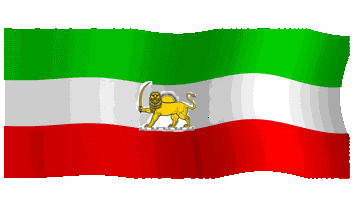The above NEW design of flag is not to impose any kind of flag
to our country or to promote a drawing that a young artist made for self,
without any pretension, following a conversation that broke between artist
and another friend.
To see flag demo/flash please click on the flags
above
نمونه پرچم های پيشنهادی بالا به هيچ گونه تحميلی بحساب نمی آيد. اين
پرچم ها با فکر صاحب اين تارنما از سوی يک هنرمند ايرانی برای اين
تارنما فراهم شده است باشد که روزی بجای شمشيری که نماد
خونريزی، جنگ و نماد شکست ايرانيان در مقابل هجوم بی امان تازيان
بوده است يک مشعل که نماد دانش، همبستگی، گرما، و نماد يگانگی است
جايگزين شود.
ايرانی ميهن پرست اين نشان را به شخص يا قبيله خاصی منسوب نمينما
يد.
For Parsi Version please see page 1&2


As we all (Iranian) are concerned about the future of our country, the
deliberation will be upon us about the kind of flag we should have in a new and
liberated Iran.
The above design has been circulated to over 3000 people. I am delighted to
announce that many concern Iranians expressed overwhelming interest in this
issue.
Before we decide these are the questions that we face:
-
Does the current Iranian flag (with foreign writings
on it) represent every Iranian, including all ethnic groups and
"Iranian" in whole?
-
Should we have our famous "Shir-o-Khorshid" flag
back?
-
Should the lion on the flag look "Iranian"; or,
resembles to other lions on Non-Iranian flags?
-
Due to the fact that a secular (laic) regime is the
ultimate goal, separation of "Religion" and "State", then shouldn't
Iranian flag lose the sword, which apparently represent "Zulfaghar"?
It is believed that any form of symbol representing a religion, or a
group will be invasion of equality of rights for all, political,
religious and ethnical groups?
Artist's admiration to stylize the ancient art and nature easily is visible in
this design. Beauty, originality and worldly admiration of our history are well
implemented in the suggested model. (I draw your attention to the lions from
engraved historic heritage).In this design to well maintain and balance the logo the "White"
has to be wider. Therefore, the width of the flag is divided into 7; then, 2
parts has been used for green, and 3 for white and 2 parts for red.
We are commissioned to have our flag changed to something more
nationalistic, therefore the style of the design would also be seriously
considered.
If we are to choose the
sword
and shape of the sword (Shamshir), my continued research, and reading
some interesting texts about wars during different periods and discussing this
matter with some military specialists lead me to the following findings.
The techniques of fighting continued changing during the history in many
countries. During the antique period, the shape of the sword was straight and
short in all known civilizations such as Greece, Persia, Assyria, Rome,
etc… The sword was short because it was easier to pull out from its sheath
(ghalaf).
During Ashkanian and Sassanian, as the combats took place between two
heroes from each side, the sword became long and heavy. They used to carry it
with two hands. This same shape and type of war was adapted by the Europeans
during the middle age.
Later, when fighting on horse back became more common, the shape of the
sword also changed. It became more circled for two reasons. One, because it
was easier to pull out from its sheath on a horse. If you move your hand from
the left side of your belt to your right upper side, you will notice that your
arm makes a circular move. Therefore, the sword took a circular shape. Then,
as we can see in the architecture, an “arch” is stronger than a straight line.
Therefore, the sword, taking a circular shape was easier and faster to use,
more solid and less likely to break during the combat.
This new shape was used and is still used everywhere in the world. Of
course, in each culture, the craftsmen use their local artistic motives to
decorate the handle and the sheath, and to give a more “local” design.
Therefore, we Iranians should once and for all stop associating the curved
sword with the Arabs and accept the fact that this shape is universal. The
misunderstanding and the nonsense about the shape of the sword started from
the Ghajaar period, when, trying to include shiism in our national symbol,
they suggested that the sword was “Zulfaghar”! Aaccording to the religious
legend, “Zulfaghar” had two blades!!! this a “Legend” because the common sense
can not accept a sword with two blades! Just imagine how it was possible to
carry a sword with two blades, and in what kind of sheath they could place
it!... This is another religious nonsense made by the Islamic fantasists, like
their “hadis”, miracles, “Jen” and “Pari”!
Finally, the best solution in the future is to remove any sword from our
national
LION;
lion being by itself the symbol of majesty, power and courage! ...
To see more lions please click here:
Lions

Click on the flag to see the history about Lion and Sun emblem
To see other pages please click here:
Please click here to see traditional lions -
برای ديدن گونه های شير و بررسی شير های پرچم با شير های باستانی باقی مانده در آثار ملی اينجا کليک کنيد
Page one (1) Parsi
Page two (2) English
Page three (3)
Flag and sword new suggestion
شمشير و پرچم پيشنهاد ملی-
Lion and Sun 1000s Years History
پرچم نماد هزاران ساله
Lion and Sun History, by Ahmad Kasravi
to brows more
روی پيوند های بالا کليک کنيد و برگ های ديگر را ببينيد
|
